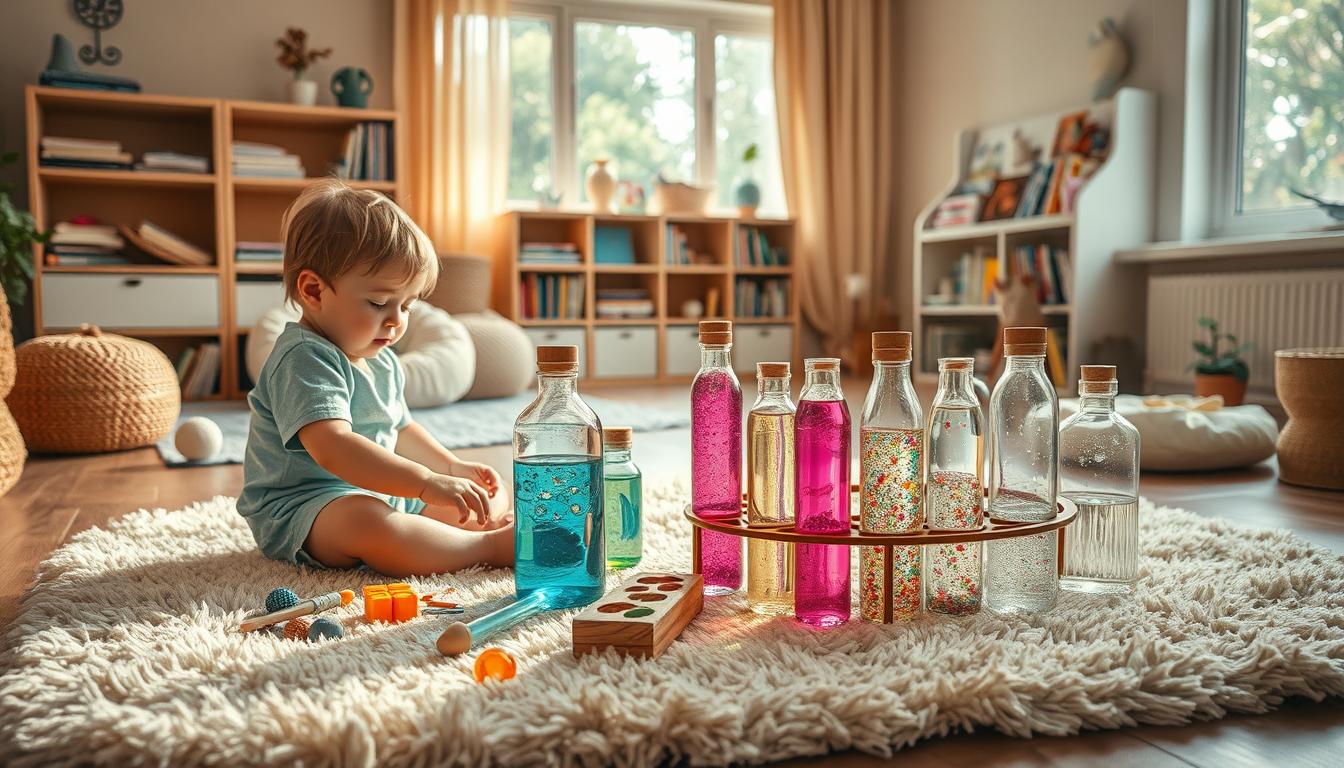Calming Sensory Activities for Kids
“The world needs all kinds of minds,” said Dr. Temple Grandin, a trailblazing autism advocate. For children who experience sensory overload, finding balance in our buzzing world isn’t just helpful—it’s essential. If you’ve watched your child struggle with everyday stimuli—a scratchy shirt seam, a crowded store, or sudden noises—you know how deeply these moments impact their well-being.
This guide isn’t about quick fixes. It’s about empowering families with science-backed methods to help kids regulate emotions, focus better, and engage more fully. Whether your child has autism, ADHD, or general sensory sensitivities, tailored approaches can transform daily life.
Every child’s needs differ. What comforts one might overwhelm another. That’s why we’ll explore adaptable strategies—from tactile play to movement breaks—that respect individual thresholds. You’ll learn to create safe spaces at home, school, or on-the-go while building lifelong coping skills.
Key Takeaways
- Sensory challenges affect learning, communication, and emotional health
- Personalized approaches prevent overstimulation while promoting calm
- Evidence-based methods improve focus and self-regulation over time
- Practical tools work in homes, classrooms, and public settings
- Understanding sensory profiles reduces meltdowns and boosts confidence
Understanding Sensory Regulation in Children
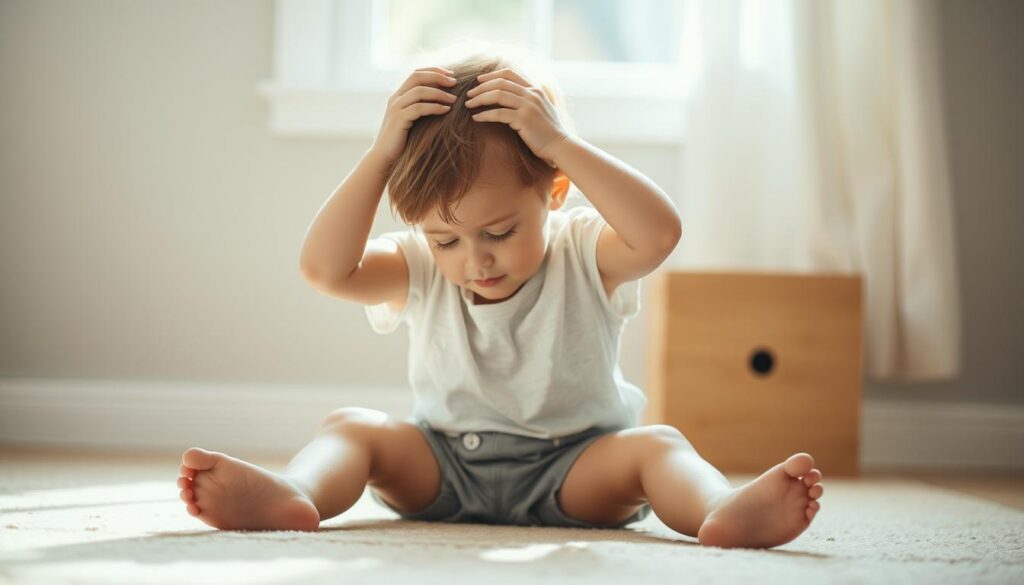
The foundation of supporting kids lies in decoding their sensory experiences. Our bodies constantly receive signals from the environment—like puzzle pieces our brains assemble. When this sensory system works smoothly, children navigate daily life with confidence. But when signals misfire, even routine tasks can feel overwhelming.
How Sensory Processing Shapes Behavior
Children interact with the world through seven senses—yes, seven! Beyond sight and sound, body awareness (proprioception) and movement perception (vestibular) play crucial roles. Some kids crave intense input—spinning or jumping—to feel grounded. Others retreat from bustling spaces, their systems flooded by ordinary stimuli.
Watch for clues: A child covering ears in noisy rooms might be avoiding auditory overload. Another who fidgets constantly could need tactile feedback. These aren’t defiant acts—they’re survival strategies for mismatched neural wiring.
When the World Feels Too Loud
Sensory overload triggers primal reactions. Imagine a system so flooded it activates fight-or-flight mode. Meltdowns aren’t tantrums—they’re distress flares signaling “I’m drowning in input.” Common triggers include scratchy fabrics, fluorescent lights, or unexpected touches.
Early warnings matter. A once-engaged child might:
• Rub eyes or ears repeatedly
• Struggle with transitions
• Become unusually clumsy
These signs whisper what words can’t: “I need a reset.”
By mapping a child’s unique sensory profile, families can transform struggles into strengths. As one parent shared, “When we stopped fighting his needs and started working with them, everything changed.” With patience, kids learn to navigate their sensory landscapes—one manageable step at a time.
Benefits of Calming Sensory Activities

Parents often wonder how to turn daily challenges into opportunities for growth. Structured engagement strategies offer more than temporary relief—they build lifelong skills. By addressing neurological needs, these methods foster resilience while meeting kids where they are.
Emotional Balance and Anxiety Reduction
Consistent routines act like emotional thermostats, helping young minds avoid extremes. When children receive tailored input—like deep pressure or rhythmic motion—their bodies release tension. This biological reset button lowers cortisol levels, making meltdowns less frequent.
Research shows kids using these techniques fall asleep 20% faster. Why? Their nervous systems aren’t stuck in overdrive. Over time, they recognize when to seek comfort tools independently—a skill boosting confidence at home and school.
Improved Focus in Daily Routines
Ever notice how fidgety kids suddenly concentrate after playground time? Movement-based strategies prime brains for learning. A 2022 UCLA study found students using targeted breaks completed tasks 34% faster with fewer errors.
Families report calmer mornings when incorporating simple practices:
• Five minutes of jumping before breakfast
• Chewy necklaces during car rides
• Weighted lap pads during homework
These small adjustments create big shifts. As one teacher noted, “When we honor their needs first, the learning follows naturally.”
Calming Sensory Activities: Techniques for Self-Regulation
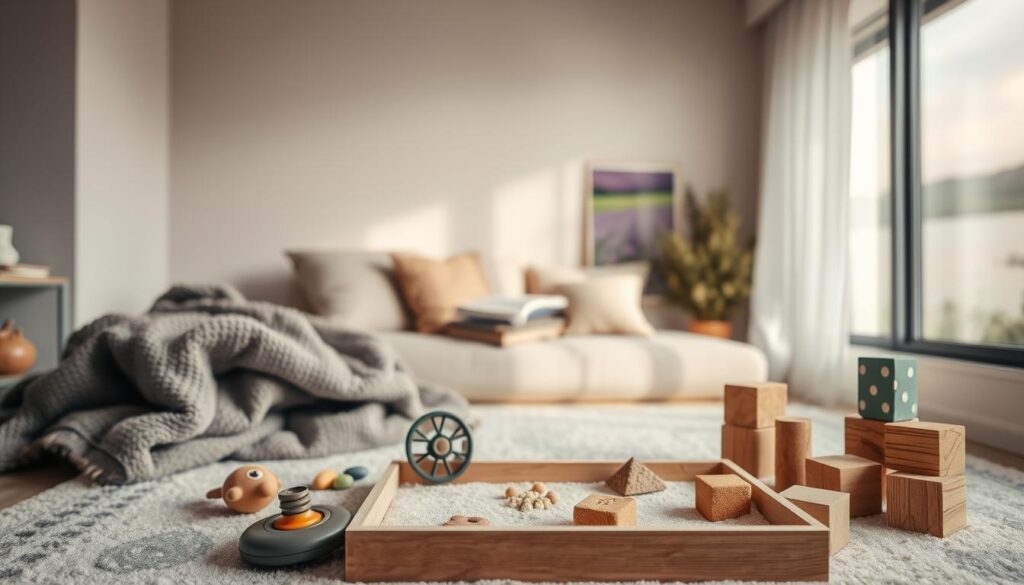
Equipping children with self-regulation tools starts with understanding their unique sensory needs. By blending proven methods with personal preferences, families can build a toolkit that grows with their child. Let’s explore adaptable strategies that meet kids where they are.
Deep Pressure and Weighted Input
Deep pressure techniques act like a reset button for overwhelmed nervous systems. Weighted blankets or lap pads provide steady, grounding input. Wall push-ups and bear hugs offer quick pressure boosts when tension rises.
Compression clothing works wonders for some kids. One parent shared, “The moment she puts on her compression shirt, her shoulders relax.” These tools help bodies feel secure, making transitions smoother.
Visual, Auditory, and Olfactory Soothers
Soft lighting reduces visual clutter. Try nature-themed projectors or pastel-colored lamps. Pair these with calming playlists featuring ocean waves or piano melodies.
White noise machines mask disruptive sounds. For scent-sensitive kids, unscented options work best. Others find lavender-scented putty helps them focus during homework.
Tactile and Thermal Sensory Strategies
Textured experiences satisfy touch needs. Kinetic sand molds easily, while sensory bins filled with rice or beans offer varied feedback. Stress balls double as fidget tools during car rides.
Temperature plays a key role. Cool gel packs soothe heated emotions. Warm wheat bags relax tense muscles. Let kids choose their comfort source—it empowers them to self-regulate.
Pro tip: Create portable kits with these essentials:
- Mini weighted stuffed animal
- Noise-canceling headphones
- Textured fidget toys
- Travel-sized lavender spray
Observe what works best each day. Flexibility turns these techniques into lifelong coping skills.
Creating a Sensory-Friendly Environment at Home and School
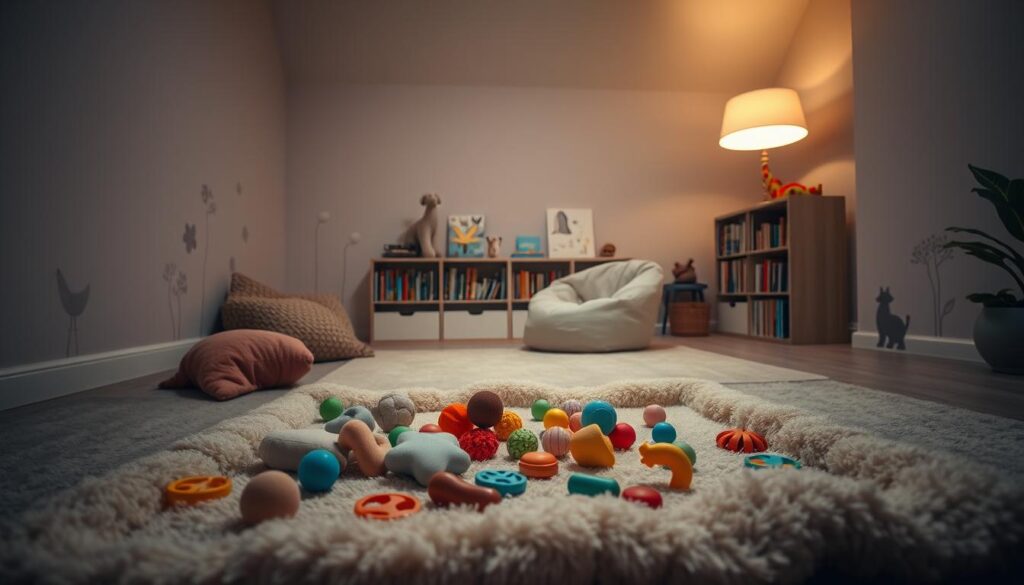
Transforming everyday spaces into supportive zones requires thoughtful design. Kids thrive when their surroundings match their sensory needs. Simple adjustments to lighting, sound, and layout can turn overwhelming areas into safe havens.
Designing Low-Stimulation Spaces
Start by creating dedicated calm zones. At home, this could be a corner with dimmable lamps, noise-canceling curtains, and soft floor cushions. Keep sensory tools like textured fidgets or weighted lap pads within reach. One parent noted, “Our reading nook became her reset button after school.”
Classrooms benefit from similar tweaks. Teachers might add wobble stools for movement seekers or soundproof dividers around desks. Visual schedules help kids anticipate transitions, reducing anxiety during chaotic moments.
Integrative Strategies for ABA Therapy
Pairing sensory supports with ABA therapy amplifies progress. Therapists might include movement breaks between tasks or let children hold stress balls during sessions. A 2023 study showed kids using these hybrid approaches mastered skills 40% faster.
Work with schools to ensure consistency. Share your child’s preferences—like needing natural light instead of fluorescents—through accommodation plans. Portable kits with noise-blocking headphones and chewy necklaces maintain regulation during field trips or errands.
Practical Activity Ideas for Daily Sensory Support
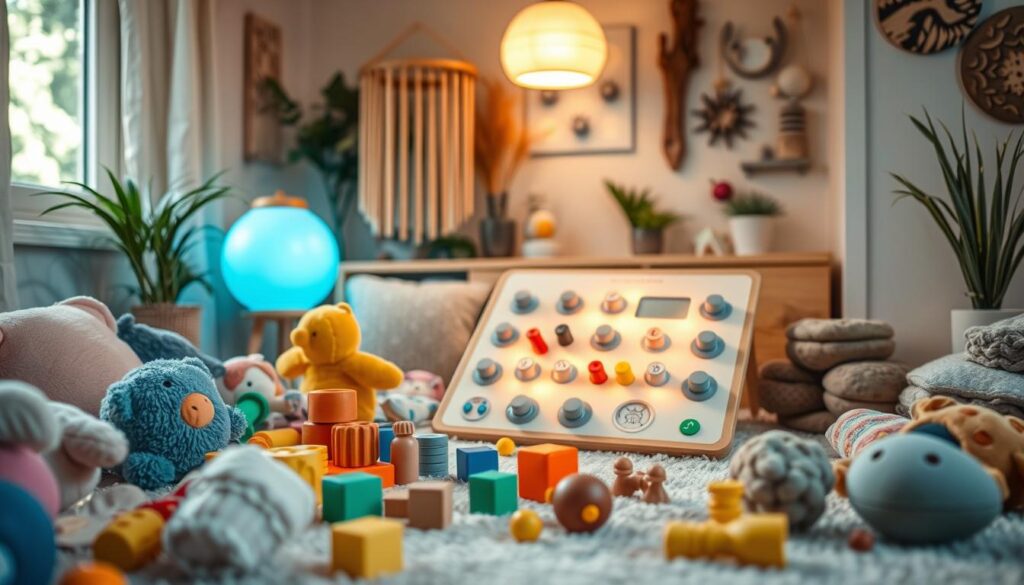
Daily routines become smoother when kids receive the right physical input. Simple movement breaks and structured play can prevent overwhelm before it starts. Let’s explore strategies that blend seamlessly into home and school life.
Calming Techniques for Meltdown Prevention
Watch for early signs like flushed cheeks or clenched fists. Offer tools like stress balls or chewy necklaces at the first hint of tension. Scheduled breaks every 90 minutes help maintain equilibrium.
Create “reset stations” with beanbag chairs and noise-canceling headphones. Teach belly breathing using fun visuals—blowing imaginary bubbles works wonders. “We practice these techniques during calm moments,” shares a preschool teacher. “It builds muscle memory for tough situations.”
Movement-Based and Heavy Work Activities
Wall push-ups during commercials or chair stacking after meals provide deep input. Trampoline jumps and obstacle courses channel energy constructively. These activities strengthen bodies while organizing the nervous system.
Indoor days? Try pillow forts or sock-skating on hardwood floors. Older kids benefit from resistance bands or yoga ball sit-ups. Rotate options to keep engagement high without overstimulating.
Most work strategies take under 10 minutes. Pair them with transitions—before homework or after screen time. Consistency turns these bursts into powerful regulation tools.
Conclusion
Every child’s path to finding balance is as unique as their fingerprint. Small, consistent efforts in daily routines can spark meaningful growth—like puzzle pieces fitting into place. Whether it’s using weighted blankets during storytime or creating quiet corners for reset moments, these tailored approaches build confidence brick by brick.
Begin with one trusted method—maybe deep-pressure hugs before homework or textured fidget tools during car rides. Observe what clicks, then expand gradually. What works today might shift next month, and that’s okay. Adaptation keeps strategies effective as kids grow.
Notice progress: A deep breath taken independently or a meltdown shortened by comfort tools deserves recognition. These victories, however small, strengthen family connections and enhance sensory regulation. Don’t hesitate to partner with occupational therapists or ABA specialists—they offer expert guidance for complex needs.
Remember, nurturing regulation skills isn’t about perfection. It’s about providing steady support while honoring individual preferences. With patience and the right tools, children learn to navigate their world with resilience—one manageable step at a time.
FAQ
How can I tell if a child is experiencing sensory overload?
What are the benefits of using deep pressure tools?
How do I create a low-stimulation space at home?
Can these strategies be used alongside ABA therapy?
What activities help prevent meltdowns during transitions?
Are heavy work activities safe for younger kids?
How often should sensory breaks be included in daily routines?

Eduard Kingly is a travel and lifestyle content creator with a focus on personal development and education. He combines firsthand travel experiences with research-driven insights to guide readers in discovering new places, building better habits, and pursuing meaningful learning.

